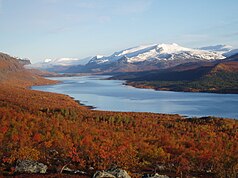Stora Sjöfallet National Park
| Stora Sjöfallet National Park | ||
|---|---|---|
| View from Saltoluokta to the north-west of the national park | ||
|
|
||
| Location: | Norrbotten County , Sweden | |
| Next city: | Gällivare , Jokkmokk | |
| Surface: | 1278 km² | |
| Founding: | 1909 | |
The National Park Stora Sjöfallet is located in northern Sweden near the Norwegian border. It is part of Laponia - World Heritage . The park was established in 1909 and covers an area of 1278 km². The Akkajaure lake now separates the park into a northern and southern part. In the entire west rise higher, partly glaciated peaks of the Skanden Mountains, of which the Akka massif in the southwest is the most impressive. It is also called "Queen of Lapland" and became well known through Selma Lagerlöf's youth book Nils Holgersson . The alpine altitude level , which accounts for the largest area of the park is by extensive, treeless Fjälltundra dominated. Especially on the south bank of the Akkajaure, light mountain birch forests stretch up to the tree line . In the lowest regions in the east, they partly change into the primeval spruce and pine forests . The mountain lakes of the river Stora Luleälven run through the national park . The Akkajaure lake is now a reservoir with a dam near Suorva. Due to the economic use of hydropower, the Akkajaure reservoir was separated from the national park again at an early stage. Due to the fluctuations in the water level (between 423 and 453 m), the shore zone of the reservoir is of little vegetation and often of a desolate appearance.
This Swedish national park takes its name from the famous Stora Sjöfallet waterfall , which can be found in the town of the same name. In the language of the native Sami people , the waterfall is called Muorkke . Before the Akkajaure was dammed up, the Stora Sjöfallet waterfall was a gigantic natural spectacle, as it was the only place where the entire amount of precipitation from the neighboring region to the west, from parts of the Sarek National Park and the entire Padjelanta National Park, drained up to the Sitasjaure Lake on the Norwegian border were. Today the water is routed through a technically sophisticated, kilometer-long underground pipe system that is used to generate energy. Only rarely, for example when the snow melts, does the flow rate increase on Stora Sjöfallet. Then you can guess how big this waterfall must have been in earlier times.
Flora and fauna
Essentially all plant communities of the Eurasian tundras can be found in the park, i.e. above all mosses and lichens , grasses , dwarf shrubs such as the dwarf birch and arctic heather , shrub-like and dwarf willow plants and ferns . Especially for the park are the Nordic Eisenhut who Fjällpestwurz ( Petasites frigidus ) or Cicerbita Alpina . Among the mammals, the reindeer herds of the Sami , mountain hare , mountain leming , northern lynx and wolverine should be mentioned. Golden plover , buzzard and ptarmigan are common among birds .
Surroundings
Sweden's largest bog wilderness area, Sjaunja, is adjacent to the national park in the northeast .
activities
The national park is easily accessible in parts, a road leads along the north bank of the Akkajaures. Apart from a section of the Kungsleden there are only a few hiking trails within the park . Some of the peaks can be climbed on day tours - with sufficient orientation experience.






